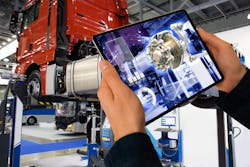When we think about the future, our minds tend to envision some sort of George Jetson-style fantasy with flying cars and robot housekeepers. But our current reality is not so far off from that. We have vehicles now that (almost) drive themselves. Our homes are cleaned by dishwashers, washing machines, and even robotic vacuums and mops. Meanwhile, in the world of commercial vehicles, we’re on the verge of operating fully electric trucks, telematics and algorithms predict our service and maintenance needs, and technicians can be trained remotely via computers and smartphones.
The future is here, it seems, or at least very close. Here are some ways to help ensure your fleet is ready.
Prepare for high voltage service
Fully battery electric heavy duty vehicles may not be mainstream right now, but it seems they’re not far off: a number of select fleets are already piloting these vehicles. In the interim, commercial vehicles continue to add higher voltage systems to accommodate additional power needs. Preparing your fleet to work with higher voltages is a major consideration.
In many ways, servicing EVs is completely different from servicing diesel engine vehicles. For starters, increased personal protective equipment (PPE) and certified insulated tools are required. While your fleet may not have any EVs now, it’s not a bad idea to start purchasing insulated tools and PPE as tool and equipment replacement cycles occur. Stocking up now ensures you won’t be caught without the proper equipment later.
Investing in EV service training is another consideration. Technicians trained to service only diesel engine vehicles may not be able to safely and effectively service EVs, leaving your fleet unprepared should they decide to invest in electric.
For more information on servicing electric commercial vehicles, read about the Volvo LIGHTS project.
Use telematics to your advantage
Even as EVs begin to enter the scene, fleets will still be using diesel engine vehicles for the foreseeable future, so it’s important to use all available tools and technologies to streamline service.
One important technology to take advantage of is the advanced telematics that have become available over the course of the last decade. On newer vehicles, telematics hardware is typically built in at the factory, but on older trucks it is still possible to add OEM or aftermarket hardware.
Telematics can monitor items such as vehicle systems, operating conditions, and mileage, and notify a fleet as soon as an issue is detected. What’s more, information collected by telematics can be compared to databases of other similar vehicles and predict when a system or component may fail, allowing the fleet to inspect, repair, or replace the system or component before that happens. This can significantly reduce unexpected downtime, maximizing the vehicle’s time on the road.
This technology will only become more important in the future, so take advantage of it now by specifying it on new vehicles or adding it to older models. It’s also important to get familiar with utilizing the data by working with either OEM or third-party services who can interpret the data and provide it to your fleet in a usable format to streamline service and maintenance.
Read more about telematics and vehicle maintenance.
Update training technologies
Technology has been a driving force behind updated technician training procedures. Options for remote training have become more widely available in recent years, allowing technicians to stay updated on the latest maintenance and service procedures, vehicle technologies, and tools and equipment without leaving the shop. This has become especially important as the COVID-19 pandemic limits travel and person-to-person contact.
Keeping the technicians in your fleet up to date now means creating or expanding digital training areas and technologies. Computers or tablets should be provided for remote training, even if they are shared by multiple technicians. One advantage to remote training is that not everyone has to train at the same time; it can be completed at staggered intervals to accommodate work schedules and avoid too much close interaction between technicians.
Fleets may also find it worth looking into newer technologies such as augmented reality (AR) or virtual reality (VR) devices. These tools can help technicians learn by overlaying what they are seeing in real life with digital text and images to guide them through steps of a process or label the parts of a particular system or component they are looking at.
Find more on technician training options.
Keeping up with the latest technologies is important for every fleet, and preparations for the future should not be neglected. EVs, telematics, and technician training are just a few examples of ways fleets can become future-proof. What is your fleet doing to stay ahead of the curve?
About the Author
David Brierley
Editor | Fleet Maintenance
David Brierley is a former editor of Fleet Maintenance magazine.
Brierley’s education and career have been based in the publishing industry. He is an award-winning writer and comes from a background in automotive, trucking, and heavy equipment. Brierley joined the Endeavor Business Media vehicle repair group in 2017 as managing editor for Fleet Maintenance, PTEN, and Professional Distributor magazines, as well as VehicleServicePros.com. In his current role, he writes for and oversees production of Fleet Maintenance magazine. He has worked in the publishing industry since 2011.

